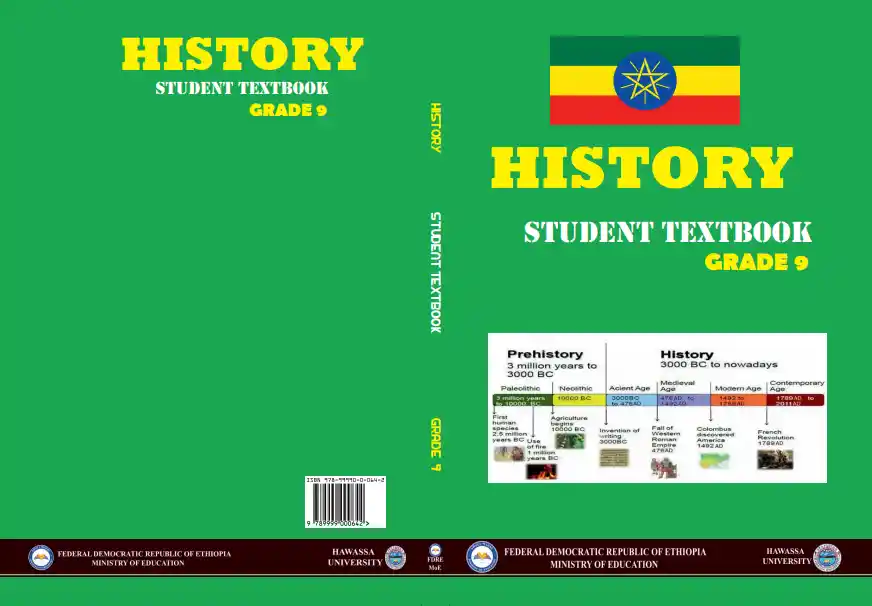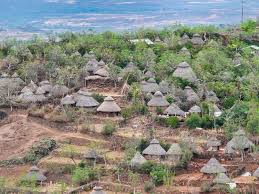The new Ethiopian Grade 9 History Textbook has been published by the Ministry of Education (MoE). The textbook was written by Desta Roba Julla (MA) and Tesfaye Masebo Melko (MA), and edited by Tigab Beze Bikis (PhD) (Content Editor), Messay Kebede Abebe (MA) (Curriculum Editor), and Girma Gezahegn Belihu (PhD) (Language Editor). The book was illustrated by Ayele Sankura Samako (MSc) and designed by Mulat Shiferaw Siyoum (MSc). The book was evaluated by Doctor Telila Buta (MA), Bekele Kenea Dugasa (MA), and Zegeye Woldemariam (MA).
To download the PDF of the new Ethiopian Grade 9 History textbook, please click button below.
10 MB
The textbook covers a wide range of topics in Ethiopian and world history, from the earliest human civilizations to the mid-19th century. The book is divided into eight units, each of which focuses on a different period of time or region of the world.
Unit 1: The Discipline of History and Human Evolution
This unit introduces students to the discipline of history and the study of human evolution. Students will learn about the different types of historical sources, how to date historical events, and the major theories of human evolution.
Unit 2: Ancient World Civilizations up to c. 500 AD
This unit examines the major ancient civilizations of Africa, Asia, Europe, and the Americas. Students will learn about the rise and fall of these civilizations, their cultures, and their contributions to the world.
Unit 3: Peoples and States in Ethiopia and the Horn to the end of 13th C.
This unit focuses on the history of Ethiopia and the Horn of Africa up to the end of the 13th century. Students will learn about the different languages, religions, and peoples of the region, as well as the major pre-Aksumite states and the Aksumite Kingdom.
Unit 4: The Middle Ages and Early Modern World, C. 500 to 1750s
This unit examines the history of Europe, Asia, and Africa during the Middle Ages and Early Modern period. Students will learn about the major events of this period, such as the rise of Islam, the Crusades, the Renaissance, and the Reformation.
Unit 5: Peoples and States of Africa to 1500
This unit focuses on the history of Africa to the year 1500. Students will learn about the different languages, religions, and peoples of Africa, as well as the major states and empires of the period.
Unit 6: Africa and the Outside World 1500- 1880s
This unit examines the history of Africa’s interactions with the outside world from 1500 to the 1880s. Students will learn about the slave trade, the “legitimate” trade, European exploration and missionary activity, and the white settlement of South Africa.
Unit 7: States, Principalities, Population Movements & Interactions in Ethiopia 13th to Mid-16th C.
This unit focuses on the history of Ethiopia from the 13th to the mid-16th century. Students will learn about the Solomonic Dynasty, the Muslim principalities, the relationship between the Christian kingdom and the Sultanate of Adal, and the political, social, and economic conditions of the period.
Unit 8: Political, Social and Economic Processes in Ethiopia Mid- 16th to Mid- 19thC.
This unit focuses on the history of Ethiopia from the mid-16th to the mid-19th century. Students will learn about the peoples and states of the eastern, central, southern, and western regions of Ethiopia, as well as the major political, social, and economic processes of the period.
Unit 9: The Age of Revolutions 1750s to 1815
This unit examines the major revolutions of the Age of Revolutions, including the French Revolution, the Napoleonic Era, and the American War of Independence. Students will learn about the causes and consequences of these revolutions, as well as their impact on the world.
I hope this information is helpful. Please let me know if you have any other questions





